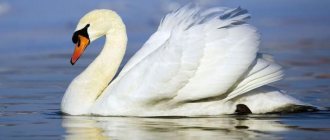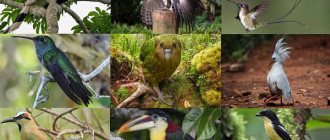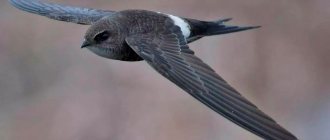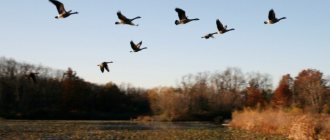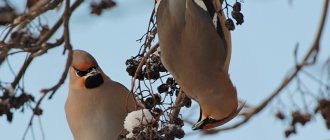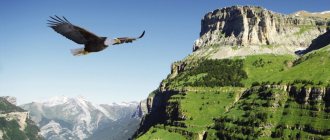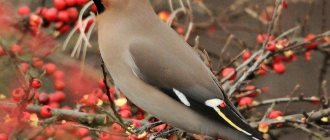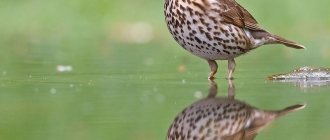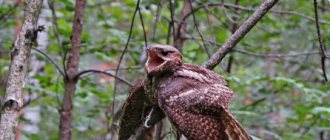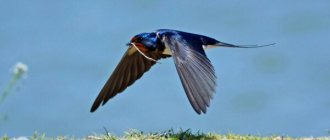A symbol of chastity and fidelity, the snow-white swan bird relatively recently began to evoke such poetic associations. Several centuries ago, in the Middle Ages, these royal waterfowl were considered common game. They were hunted not so much for their meat, which can be very tough in wild birds, but for their elastic and light down. The result of excessive hunting was their almost complete extermination in Europe, and only conservation measures in the 20th century helped preserve the remaining populations.
A symbol of chastity and fidelity, the snow-white swan bird relatively recently began to evoke such poetic associations
Interesting facts about swans
There are many interesting facts about mute cats that are known to very few people.
An adult bird can kill a small dog, coyote or fox with a blow of its wing. A swan can break a child's arm or leg. A pair of birds, guarding their brood, can kill even an adult with their wings. If birds nest in pairs, they wait out the winter in colonies. Up to a hundred or more pairs can gather on one lake. Mute birds fly well, but take off with difficulty. The heavy weight of the bird is the reason for this. To rise into the sky, a swan requires acceleration and a path of free, open water at least 50 meters long.
Swans can catch other chicks
In England, all mute cats belong to the royal family and are under their protection. And in Denmark, the mute swan is the symbol of the country.
Meaning
Birds of this genus are not common at all. In many countries they are either absent or an endangered species. Therefore, it is not surprising that some of their species are protected by law from destruction.
True, this does not always help, and they are still hunted. Most often - just for the sake of tasting a dish from them. After all, it is considered privileged. For example, in Great Britain, only members of the royal family are allowed to eat mute swans.
Well, in general, swans are beautiful birds, the simple sight of which calms and pacifies people. Perhaps that is why they are considered noble and wise birds.
Swans symbolize marital fidelity. And not in vain: having found a couple, they remain faithful to each other all their lives. Plus they are good parents.
Having given birth, the swan couple takes care of their chicks together until they become adults. Let's take a closer look at these beautiful birds: how they build their family and raise the younger generation.
Swan feeding
Description of the chamomile flower: photo, description, structure, application and beneficial properties
Birds feed either from the surface of the water or by getting food from the bottom. They do not know how to dive, and to get to the bottom silt or aquatic parts of plants they use their long neck. They prefer to feed in shallow water. The diet of the mute swan in nature consists of:
- From underwater and above-water parts of various plants,
- algae,
- Young shoots of reeds and reeds,
- Small shellfish,
- insects,
- Larvae,
- Benthic invertebrates,
- Crustaceans.
Birds very rarely leave a body of water, but in search of food they can get out onto land and feast on young grass or berries.
Young animals prefer to eat food of animal origin: insects, mollusks, invertebrates. This is explained by the fact that they need a lot of protein for growth and development.
During the migration period, flocks of swans often stop at rural fields, causing great damage to farmers. They readily eat grain and winter crops, potatoes, corn, and grapes. They trample much more than they eat.
Chicks at home
Very often, keeping swans at home begins with the purchase of chicks. Young swans are quite unpretentious and independent, do not require artificial feeding and are in good health. Infant mortality among chicks is very low. It is better to buy babies at the age of 14 - 20 days. In order for the chicks to grow and develop well, they need an aviary and a pond, as well as several dry areas with a house or nest. Feeding the chicks is not difficult. Babies can be given:
- Live fish fry,
- Corn,
- Sprouted grain,
- Vegetables and fruits, root vegetables,
- Fresh chopped herbs
- Dairy products,
- Boiled eggs,
- Compound feed.
The chicks will spend most of their time on the water, collecting various invertebrates and aquatic plants from the bottom. It is recommended to install several feeders near the pond, where the food will be poured.
- Author: Maria Sukhorukikh
Rate this article:
- 5
- 4
- 3
- 2
- 1
(0 votes, average: 0 out of 5)
Share with your friends!
Swan bird. Swan lifestyle and habitat
Bowerbird nests: photos and videos
Today, these beautiful birds are a symbol of spiritual purity, purity and marital fidelity. We bring to your attention information about swans: a description of their appearance, character and life characteristics.
In nature, as a rule, these birds live in sparsely populated bodies of water, which are overgrown with reeds and reeds. During cold weather, they fly away to warm countries, and when spring comes, they return. The female builds a nest in the thickets, and the chicks appear by mid-summer. A baby swan is born feathered and can immediately get its own food. The female stays with the swans for about 6 months until they are fully grown.
It is rare to see a swan on land. This bird prefers to spend time on the water. She is very careful and prefers quiet, calm places, away from noise and people. But sometimes you can meet couples that live close to a person’s place of residence. This may mean that the birds are fed and treated very well.
It is worth noting that these birds are often found in the northern hemisphere. Although they often choose to live in New Zealand, Australia and South America.
The male and female are not much different from each other. The white swan is one of the largest waterfowl, differing in size and weight, which reaches 10-13 kg. Its body is elongated, long (about 150-170 cm), its neck is long and looks very elegant. The strong wings have a span of almost 2 meters, the legs are short, dark in color, and located slightly behind. The beak is gray or black and yellow.
It is worth noting that young individuals have a pink beak, the tip of which is painted black. A swimming bird has a neck stretched vertically upward, while its head and beak look forward. But if we talk about the species of mute swans, then it differs in that it has a red beak. While in the water, it adopts a pose with a curved neck that resembles an S-shape. At the same time, its wings are slightly raised, and its beak is lowered down.
A lot has been said about swans, and especially about their snow-white plumage and a large amount of soft and delicate fluff. Their unsurpassed grace and regal grandeur can be seen below, where a photo of swans in all their glory is presented.
They say a lot about swans that they have a calm and peaceful character. But if they feel danger or a threat to their lives, they are able to defend themselves. At the same time, they create hissing sounds, strongly flap their wings and use their beak as a weapon.
Among these birds there are both peaceful species and those with a rather aggressive character. Black-colored individuals are peaceful, but the Mute usually shows aggression, which can even attack a person and break an arm with a blow from a strong wing.
But if this bird gets to a person as a chick, it becomes practically tame and gets used to its owner. She is not afraid of noise or people around her. She adapts to her new habitat and gets along well with poultry and animals.
Fascinating facts about swans interest many. And there really is a lot of mysterious and interesting things here.
- There are many beliefs about swans and their fidelity to their partner until the end of their lives. But one thing is certain: the swan is a monogamous bird and, having created a pair, it remains nearby as long as the companion is alive. But having become a widower, the male or female will create a new pair, and will not remain a hermit until death.
- This bird looks great due to the fact that its body is covered with very thick plumage (this can be seen in any photograph). And few people know that the number of feathers is 25 thousand units. This bird is a record holder, but during seasonal molting it loses a lot of feathers and cannot fly for some time.
- Regardless of which swans we are talking about, white or black, their chicks appear covered with gray down and only over time acquire feathers of a certain color. Snow-white feathers appear only in the third year of life.
- The coloring of an individual directly depends on what climatic conditions the bird has chosen. If a swan lives in the southern regions, then the color takes on a darker shade, and when it lives in northern countries, the feather becomes perfectly white. Below are photographs that show the colors of the plumage.
- An interesting description about black swans was made by ornithologists. It is in this species that same-sex marriages occur, and the female is attracted only to bear the egg. After which she is driven away, and the males are engaged in hatching and raising.
Raising chicks
Not only the mother, but also the father swan is involved in raising the chicks. In the event of the death of one of them, the surviving parent can perfectly cope with this responsibility himself. It is interesting to observe how a pair of black swans distribute parental responsibilities. The chicks hatch within a few days. While the mother sits on the eggs remaining in the nest, the father takes the older ones out to the water.
The necessary conditions
Swans are also raised in captivity. At the same time, it is necessary to create conditions for them that are as close as possible to their natural habitat. The necessary conditions:
If the swan family does not fly away for the winter, you need to prepare a winter house for it, in which the entire population can hide from rain, snow and frost.
What to feed little swans
The babies take their first “steps” in the water and immediately begin to get their own food:
- vegetable: duckweed, small algae;
- small animal matter: larvae of various insects, fry, small crustaceans, invertebrates living at the bottom of the pond.
Hunting for food takes place near the shore, in shallow water, where swans can dive on their own.
In a household setting, you need to ensure that the menu of future swans and their parents is varied and balanced. The menu should include:
- food of animal origin: chopped meat, boiled eggs, bloodworms, bone meal, live fry, dairy products;
- plant foods: duckweed, grass flour, mixed feed, cereals (millet, millet, corn), vegetables (cabbage, carrots, lettuce), root vegetables.
How does the learning process work?
Parents are involved in education and training. For the first 5–6 months, the swans are not separated from them. Mom and dad take care of the babies together, help them get food, and protect them from birds of prey and animals. The teaching method that all swans use is their own example. Skills that parent couples teach their young:
- swimming is built on an instinctive level: immediately after birth, babies, following their parents, plop into the water and feel like a “fish in water”, while thick fluff protects them from cold water;
- getting food: watching the mother dip her long neck into the water and take out something tasty, the swans repeat after her, diving under the water and finding some kind of delicacy at the bottom of the shallow water;
- flights: chicks will be able to fly only after the first molt (down is replaced by feathers), then they are ready to make seasonal flights after their parents.
You can often see a picture: a swan is swimming, and all its offspring are perched on its back between its wings. On this comfortable and reliable “ship” the chicks can warm up and relax after a tiring voyage.
How do young animals molt?
Shedding takes place in two stages:
- The down is replaced by a “teenage” feather of a gray-brown color, after which the younger generation begins to fly.
- “Adolescent” plumage gives way to “adult” plumage with a characteristic coloration for the species.
The first moult occurs at different times in all species:
- the small or tundra swan fledges earlier than others (after 45–50 days): this is due to the short northern summer, during which it needs to have time to fledge and prepare for a long flight;
- Black-necked swan offspring molt at 3 months;
- mute mute cubs put on feathers at 100–120 days of age, after which they can separate from their parents;
- juveniles of the black species change down to feathers after 5–6 months.
Fledged young often gather in flocks and rehearse flights, thereby preparing for the autumn migration to the south.
Swan: description
Mandarin fish photo and description
Swans are large waterfowl that belong to the Anatidae family and the Anseriformes order. There are only seven species of such birds left on Earth, and 10 species have become extinct. It turns out that there were about 17 species, some of which disappeared and, of course, not without human participation. Swans are also distinguished by the fact that they have a unique plumage color, consisting of white, black and gray shades.
Appearance
Swans are among the largest waterfowl, with a wingspan of almost 2 meters and a weight of at least 15 kg. The plumage is pure white, as well as coal black or gray shades.
But the beak may differ from the traditional color, as it can be gray or dark yellow. Species such as the black swan or mute swan tend to have a red beak color. Above the beak, regardless of the type of bird, there is a characteristic growth. Its color depends on the type of bird, so it can be black, red or yellow.
Swans can be distinguished from other representatives of this family by their long necks, with the help of which they find food items in the water. These birds have rather short legs, so they are not as comfortable on land as in water, and their find may not look as attractive as their appearance. At the same time, it should be noted that swans have well-developed wing muscles, so they look no less impressive in the air as in water.
Swans fly south in the fall, creating an indelible impression. They fly over the territory, with some sad cries, as if saying goodbye to this place until next spring.
It is not at all easy to distinguish a female adult swan from a male, since they have almost the same size, as well as the same plumage color. The swan chicks that are born are not distinguished by their gracefulness and it is simply hard to say that these offspring of swans, since the color of their plumage (down) is more of various dirty gray shades.
Character and lifestyle
As a rule, swans spend the bulk of their lives in water. They can be easily distinguished from other species of waterfowl by their leisurely movement across the water surface with a dignified and stately appearance. Swans get their food by using their long necks, which they submerge in the water. In this case, only the back part of the bird with its tail can be seen on the surface of the water.
When they are in their natural environment, they behave quite cautiously and can stay away from the shore, where serious danger cannot lurk
In case of danger, swans try to swim as far as possible. If this does not help, then the birds try to use their wings, scattering across the water. When they flap their wings, it appears as if they are running on water. This way they escape from pursuit much faster. In extreme cases, when they are in mortal danger, swans take to the air. In some cases, swans dive underwater to escape.
If swans live in parks or zoos, then they begin to understand that no one is threatening them and quickly get used to the fact that people pay attention to them. Therefore, they begin to trust people and accept food from them
Swans, despite the fact that they are birds, can fiercely defend their territory and do not tolerate other neighbors or competitors nearby. This is especially true for already established couples.
Swans can be slightly aggressive if someone dares to disturb their territory. They are not afraid of anyone, including humans. You need to know that these are strong birds with a wingspan of up to 2 meters. With one blow of their wing they can easily break the offender's arm. At the same time, we should not forget about such a formidable weapon as the beak. Swans that live in parks or gardens are not as aggressive towards humans, understanding that humans will help protect themselves from other enemies. In such cases, they allow the person to approach, receiving food from him.
Regardless of the species, swans are migratory birds, so with the onset of autumn they gather in flocks and leave populated areas. They winter in warm countries, choosing the coasts of various bodies of water for this purpose. With the onset of spring they return.
Birds fly in flocks, and the leader flies ahead. The flock forms a kind of clique in the air.
How long do swans live
Swans are birds that can live at least 20 years in the wild, and up to 30 in captivity. There is a legend that states that swans can live about 150 years. Unfortunately, this is just a legend that has nothing to do with real data.
Swans are graceful birds. About swans for children
Watch this video on YouTube
First flight
Typically, swan cubs begin to fly immediately after their first adult moult. This same time for most cubs marks the beginning of adult independent life. Very often, young birds gather in large flocks and prepare for migration by making training flights over the nesting territory. However, this does not mean that parents drive away their chicks. The young remain close to their parents and even make autumn and spring migrations with their family. There are cases when a parent couple continues to take care of their already grown children into the next year. This usually happens in cold summers, when swans refuse to lay a new clutch due to lack of food or abundant snow cover.
Autumn migration for almost all swan species is slower due to young birds. Flocks make long stops to feed and rest.
During the flight, young animals stay at the back of the flock or wedge - air resistance there is much lower than in the front rows.
What do young swans eat?
Almost all little swans leave the nest from the first days of their lives and follow their parents in search of food. The babies are covered with dense and very warm down, so they are not afraid of the cold winds of the northern summer, rain and rather cold water. They can bask under the wings and on the backs of their parents.
Unlike adult birds, swans dive well. It is this skill that helps them get food from the bottom.
The chicks' first food is small algae and duckweed, insect larvae, fish fry and bottom invertebrates. Swans with a brood prefer to feed in shallow water, taking their offspring to deep water only in case of danger. In shallow water, kids have the opportunity to get from the bottom not only silt, but also mollusks and crustaceans. If kids are unable to handle the sink, parents come to the rescue.
What does a swan chick look like?
Adult birds of different species differ from each other in plumage color. They come in white, black and black and white. But swans of all species look almost the same. They are dressed in downy coats of gray, light gray and gray-brown shades. Thanks to such a dim coloring of the chicks, it is easier for parents to hide them from predators. The first feathers of teenage swans are also painted in a protective color. The cubs will be covered with feathers of an “adult” color only with the onset of puberty at the age of three (before the spring migration).
Types of swans
There are currently seven species of swans in the world:
- whooper swan;
- mute swan;
- trumpeter swan;
- small swan;
- American swan;
- black Swan;
- black-necked swan.
Whooper
One of the most common types of swans. These birds nest in the northern part of Eurasia, from Iceland to Sakhalin, and in the south their range extends to the Mongolian steppes and northern Japan. It differs from its other relatives in the trumpet call it makes during flight, which carries over long distances. The color of the down-rich plumage of whoopers is snow-white. Their beak is lemon yellow with a black tip. Another external feature of these birds is that on the water they do not bend their necks like other swans, but hold it strictly vertically.
Mute
Unlike the whooper, which is outwardly similar to it, when swimming it bends its neck in the shape of the Latin letter S, and holds its head inclined to the surface of the water. Due to the fact that the mute mute is generally larger and more massive than the whooper, its neck visually looks thicker and from a distance appears shorter than it actually is. When flying, the mute mute does not make trumpet clicks, but the sound of its large and strong wings cutting through the air, accompanied by a characteristic creaking sound emitted by wide and long flight feathers, can be heard from afar.
Mute mules live in the middle and southern regions of Asia and Europe. Their range stretches from southern Sweden, Denmark and Poland in the west to China and Mongolia in the east. However, even there you can rarely meet these swans, as they are very cautious and distrustful.
Trumpeter Swan
Outwardly similar to the whooper, but, unlike the yellow-black beak of the latter, its beak is completely black. Trumpeters are large birds, whose weight reaches 12.5 kg, and body length - 150-180 cm. They live in the North American tundra, their favorite nesting places are large lakes and wide, slowly flowing rivers.
little swan
This species, nesting in the tundra of Eurasia, ranging from the Kola Peninsula in the west to Kolyma in the east, is also called tundra. What distinguishes it from its fellows is that the small swan is much smaller in size. Its body length is 115-127 cm and its weight is about 5-6 kg. The voice of a tundra swan is similar to the voice of a whooper, but at the same time it is somewhat quieter and lower. Its beak is mostly black, only the upper part is yellow. The little swan likes to settle in open water spaces, and, on the contrary, tries to avoid forest reservoirs.
American swan
It looks like a small one, only it may be a little larger than the latter (up to 146 cm) and its neck is slightly shorter and thinner. The color of the beak is almost completely black, except for a couple of small bright yellow spots in its upper part, located on the sides.
Previously, this species was widespread and lived in the North American tundra. But nowadays it doesn't happen very often. It prefers to winter along the Pacific coast to California in the south and the Atlantic Ocean to Florida. It is also found in Russia: in Anadyr, Chukotka and the Commander Islands.
Black Swan
This bird is distinguished by almost black plumage, only the flight feathers on its wings are white. Many black swans have individual inner feathers that are also white. They shine through the upper, black feathers, so that the overall tone from a distance may seem dark gray, but up close, if you look closely, you can see concentric white stripes diverging from the main black color. Even the paws of this species are black, exactly the same as the upper feathers. The beak is a very bright red color and has a white ring on the front.
Black swans are slightly smaller than mute swans: their height ranges from 110 to 140 cm, and their weight is from four to eight kilograms. It has a very long neck, consisting of 32 cervical vertebrae, thanks to which the bird can engage in underwater hunting in deeper bodies of water. Unlike the mute, the black swan can make trumpet sounds, calling on its relatives or expressing dissatisfaction. They live in Australia and Tasmania. But in Europe, as well as North America, black swans are also found, however, as semi-wild birds living in parks and nature reserves.
Black-necked swan
It differs from the rest of its relatives in the unusual two-color color of its plumage: its head and neck are painted black, while the rest of the body is snow-white. Around the eyes there is a narrow white frame in the form of a stripe. The beak of these birds is dark gray, at its base there is a large bright red growth. The legs of black-necked swans are light pink. These birds live in South America, from Chile in the north to Tierra del Fuego in the south, and fly to Paraguay and Brazil for the winter.
Conservation status
In recent years, the number of little swan has begun to recover, especially in the western part of its range. It currently reaches 25,000–30,000 birds , but significantly fewer nest each year. The existence of the small swan as a species currently does not cause concern - IUCN (LC), however, it is included in the Red Book of Russia as being restored.
On migration and wintering grounds, this species is protected in accordance with some international conventions (Bonn, Berne on the conservation of waterfowl) and bilateral international agreements (with the USA, Japan, India, North Korea).
Video
What do domestic swans eat?
The diet of domesticated or domestic swans very often differs from what swans eat in the wild. The explanation is simple - the diet of birds is more balanced and varied, since humans can provide birds with a large selection of different foods. However, it is worth remembering that the diet should still be as close to natural as possible.
Swans should be fed natural food of plant and animal origin.
The former include grass, hay, root vegetables and vegetables, fruits and grains. The second includes meat waste, milk and dairy products, meat and fish. Dairy products are especially important in the diet of young birds - young birds will grow more actively if they are given a little fermented milk or cottage cheese.
Regardless of age, a white swan can be fed with small live river fish. If the fish is very large or has been frozen, it is recommended to boil it or grind it into mince. Very often, minced fish is fed to birds during the molting period. Fish contains a lot of animal proteins and important amino acids necessary for the formation of fluff and feathers.
In the summer, it is very important to provide birds with green, fresh food. You can give: From root vegetables you can feed:
From root vegetables you can feed:
Gallery: swans (25 photos)
Depending on the species, these birds can be migratory, partially migrating, or remaining in their habitat for the entire winter season. White swans can fly considerable distances during migration. Due to the greed of people and insensitivity to beauty, due to poaching and unlimited hunting, swans Mute mutes are absent from many of their former habitats or are extremely rare there. A distinctive feature of the mute mute is a large black growth, or bump, at the top of the base of the orange-red beak
Swans and man
For humanity, swans represent beauty, romance, are a symbol of rebirth, purity, nobility and wisdom, which is caused by their graceful body structure, ability to fly and swim and monogamy.
The whooper swan has been declared the national bird of Finland. The mute swan is the national bird of Denmark. The black swan is the emblem of Western Australia, whose motto is " Cygnis Insignis"
"(Carrying the Sign of the Swan").
In Great Britain, mute swans are the property of the Queen, and only members of the royal family are allowed to eat swans.
The swan is sometimes considered a symbol of Martin Luther. According to legend, the reformer Jan Hus said during the burning: “Today you roast a goose, but a swan will rise from the ashes, and you will not destroy it.” The swan was often depicted in Lutheran painting, on liturgical books, and sometimes in sculptural decoration. It can also be seen on the spiers of some Lutheran churches, for example, in the German city of Monschau.
Hunting for swans is often prohibited when a particular subspecies is at the point of extinction. The main purpose of hunting is swan down. According to the writer-hunter S. T. Aksakov (1852), swan meat “is so tough that, despite preliminary soaking for two days, it was difficult to chew it,” and the taste “was similar to a wild goose, but the goose is much softer, juicier and tastier "
Nevertheless, according to eyewitnesses, in ancient times in Rus' they ate fried swans, and this dish was considered a privileged dish.
This is how the Austrian diplomat Sigismund Herberstein, who visited the Grand Duchy of Moscow twice (in 1517 and 1526), described this ceremony in “Notes on Muscovy” (1546):
“From Peter’s Day, the meat-eaters are served at the table: swans, swan giblets, cranes, herons...” - reported in Chapter 64 of Domostroi (circa 1550).
Swans were served “with topeshniks,” that is, with sliced kalach dipped in melted butter, and “swan offal” was served with “honey broth,” sometimes together with boiled beef or in pies.
According to the testimony of Peter Petrey de Erlesunda, the envoy of the Swedish king Charles IX (1604-1611), “if there are no fried swans on the table, then there is little honor for the owner,” as well as for the guests, for whose reception this ceremonial dish was not prepared.
In the “List of Royal Dishes” - a list of dishes served on various days at the royal table, compiled for the Polish prince Vladislav, elected by the Moscow Tsar in 1610, in order to acquaint him with the order at the Moscow court - we find:
Natural enemies
The small tundra swan has almost no natural enemies. Even arctic foxes and foxes try to avoid it to avoid an aggressive attack. Despite its external fragility, the bird can give a serious fight.
She rushes at her opponent without hesitation, trying to strike with the fold of her wing. Moreover, the force can be such that it breaks the enemy’s bones.
The only threat to birds is humans. When he approaches, the female takes her chicks away and hides with them in the thickets of grass. All this time, the male distracts attention and tries to drive the unwanted guest away from the nest, often pretending to be wounded.
Now hunting for them is prohibited, but poaching is carried out quite often. It happens that small swans are simply confused with geese.
Breeds of swans and their characteristics
There are 7 varieties, similar to each other in lifestyle.
A British city is ready to pay $380 thousand for information about the murder of a local gooseCurly pigeons Frillback The wonderful world of birds: 10 unusual birds from all continentsWhat determines the color of bird eggs?
- Whooper swan. It lives in the tundra and taiga forests of Eurasia - from Iceland in the west to Sakhalin in the east. It got its name from the booming trumpet calls it makes. The difference between the breed is the yellow color of the beak and the shape of the neck. It is straight, and not curved, like other representatives. Body weight from 8 to 12 kg. The feather color is snow-white, the legs are black. Juveniles are gray in color. The bird flies high - there is a known case when a flock rose to a height of 8200 m. Whoopers nest on river banks or swamps, always in the same places.
- Mute swan. The length of the body can reach 180 cm. The weight of the male is 10-16 kg, the female is 2 kilograms lighter. The red beak of the bird is decorated with a large black growth. The swan makes loud hissing sounds. Range: north and south of Eurasia, Australia and South Africa. Birds settle in swamps, overgrown ponds and lakes, and try to stay away from humans. When swimming, the mute raises its wings slightly, which distinguishes it from other swans.
- Trumpeter swan. Large waterfowl with white plumage and a body length of 160-180 cm. A characteristic feature of the bird is a large black beak with a longitudinal pink stripe. The bird's voice cannot be confused with anything else. Announcing his takeoff, the trumpeter emits a long cry and shakes his head. Now there are 2 bird colonies in the world. One of them is in the North American Rocky Mountains, the other is in southern Alaska.
- Black Swan. Lives only in Australia. It is not a migratory bird. The size of an adult individual reaches 130 cm, weight - 7 kg. The plumage is black, the paws are also black. The beak is bright red, decorated with a white edging. Interesting fact: the bird's neck consists of 31 vertebrae, which gives the bird the ability to get food deep underwater.
- American swan. The smallest representative of the species. The body, covered with white feathers, reaches 140 cm. Weight is 4-9 kg, wingspan is up to 190 cm. The life of a representative of the American breed passes in the inaccessible tundra forests of America and the northern part of the Far East. Flocks winter on the coast of the Pacific and Atlantic Oceans.
- Black-necked swan. The length of the bird is 120-140 cm, weight reaches 6.5 kg. A distinctive feature of the subspecies is the nature of the plumage. The body of the bird is white, and the head and neck are painted black. The eyes are bordered by a white stripe. There is a massive red growth on the dark gray beak. The black-necked swan is distributed in South America - from Chile to the Falkland Islands. Inhabits the shores of lakes, swamps and sea bays. The birds fly to the north of Paraguay for the winter.
- Small swan. The appearance is similar to a whooper. Body length is 112-125 cm, weight is about 6.3 kg. The plumage color is white. The beak is black, yellow at the base. The little swan lives exclusively in the tundra forests of Russia. There are western and eastern populations of the species. The first has nesting sites on the territory of Yamal and Taimyr, the second - in the forest-tundra of the Yenisei River valley.
